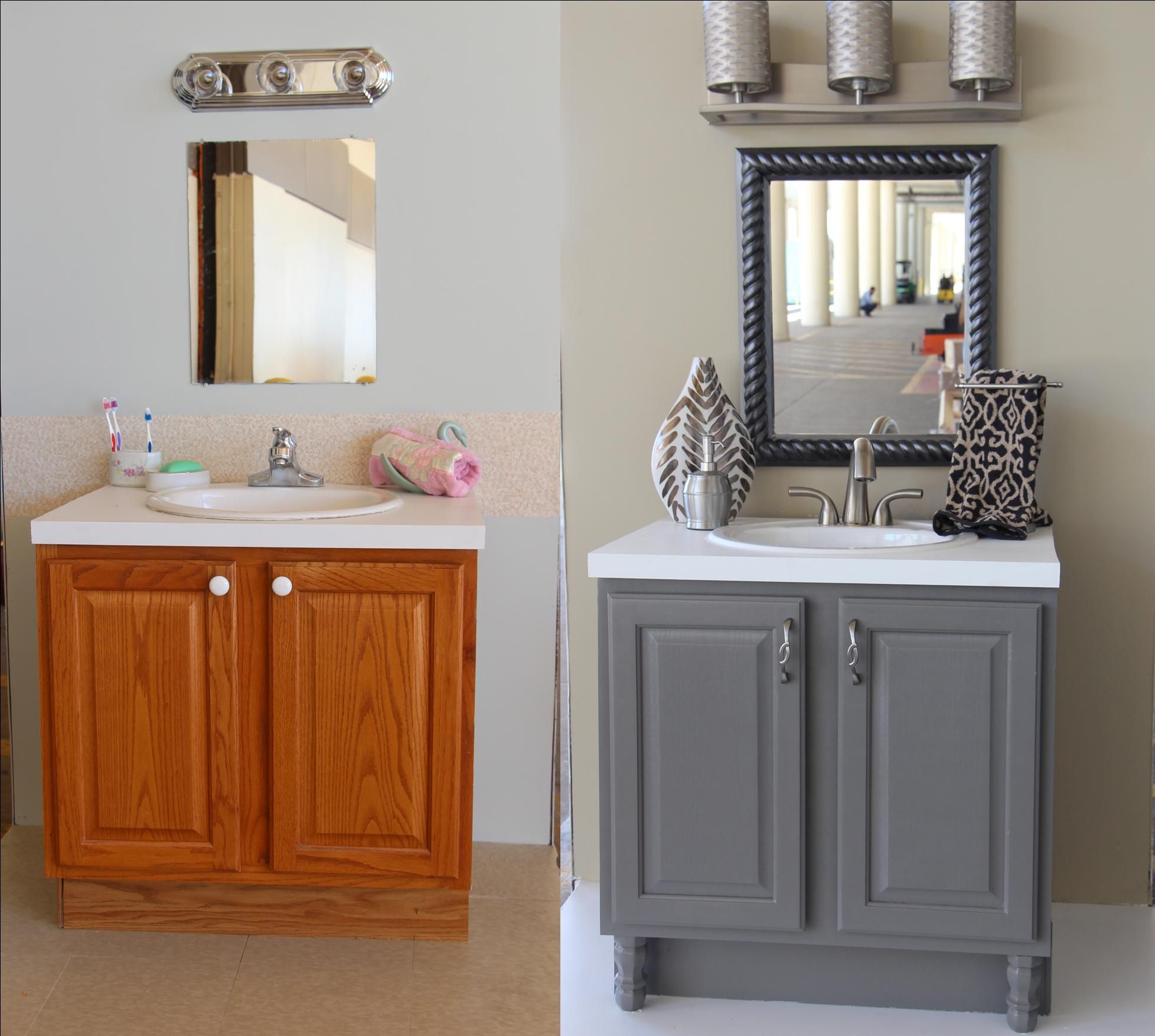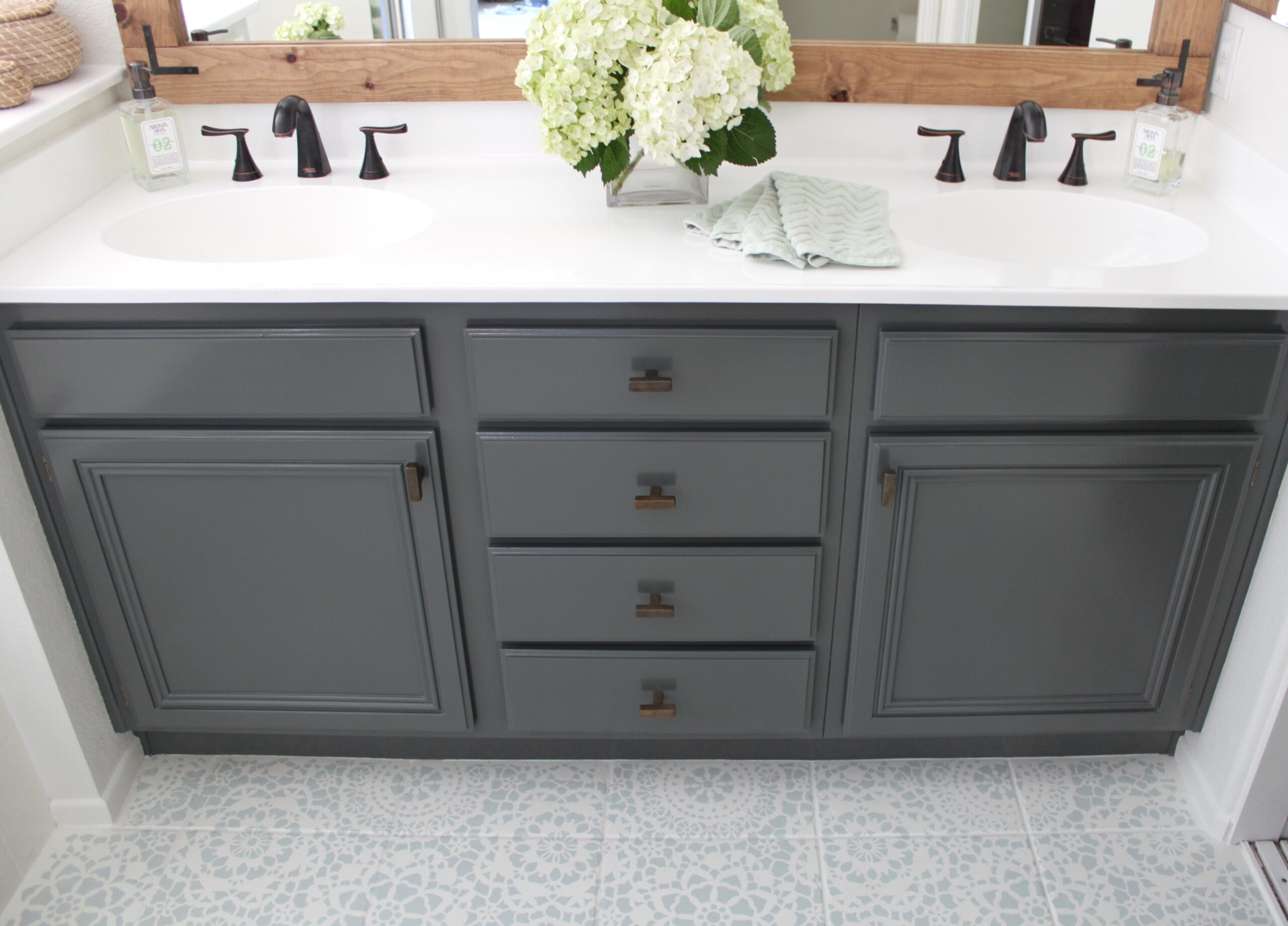The Importance of a Bathroom Cabinet Makeover: Old Bathroom Cabinet Makeover

A bathroom cabinet makeover can significantly enhance the overall appeal and functionality of your bathroom. It’s more than just a cosmetic upgrade; it’s an investment in creating a more enjoyable and efficient space.
Aesthetic Enhancement
A fresh coat of paint, new hardware, or even a simple re-organization can transform the look of your bathroom cabinet. This updated aesthetic can have a cascading effect on the entire bathroom, making it feel more modern, stylish, and inviting. For example, replacing outdated cabinet doors with sleek, modern ones can instantly elevate the bathroom’s ambiance, while a fresh coat of paint can match the overall color scheme, creating a cohesive and harmonious look.
Improved Storage and Organization
A bathroom cabinet makeover offers an excellent opportunity to optimize storage space. By adding shelves, dividers, or drawer organizers, you can maximize the cabinet’s capacity and create a more efficient system for storing toiletries, medications, and other bathroom essentials. This improved organization can reduce clutter, create a sense of calm, and make it easier to find what you need. For example, installing pull-out drawers or tiered shelves can provide easy access to items that are often hidden at the back of the cabinet, while using clear containers or labels can make it easier to identify and locate specific items.
Enhanced Mood and Ambiance
A well-organized and aesthetically pleasing bathroom cabinet can significantly improve the overall mood and ambiance of the bathroom. A clutter-free and visually appealing space promotes a sense of calm and relaxation, creating a more enjoyable experience for both you and your guests. A well-lit cabinet with strategically placed decorative items can add a touch of elegance and personality to the bathroom, making it a more inviting and enjoyable space to spend time in.
Planning Your Bathroom Cabinet Makeover
Transforming your bathroom cabinet from drab to fab requires careful planning. A well-thought-out approach ensures a successful makeover that meets your needs and aesthetic preferences.
Assessing Your Needs and Desired Outcomes
Before diving into the makeover, it’s crucial to understand your current needs and desired outcomes.
- Evaluate Existing Storage: Determine the current storage capacity of your cabinet. Consider if it’s sufficient for your bathroom essentials. Are you lacking space for toiletries, towels, or medications?
- Functionality: Identify the key functionalities you desire in your cabinet. Do you need easy access to specific items? Do you need to accommodate bulky items like hair dryers or styling tools?
- Aesthetic Preferences: Define the overall aesthetic you envision for your bathroom. Do you prefer a modern, traditional, or farmhouse style? Consider your existing bathroom décor and choose a style that complements it.
Creating a Budget, Old bathroom cabinet makeover
Setting a budget is essential for a successful makeover.
- Materials: Consider the cost of paint, hardware, shelves, organizers, and any other materials you need.
- Labor: If you plan to hire a professional for installation or painting, factor in labor costs.
- Contingency: Allocate a buffer for unexpected expenses.
A realistic budget helps you make informed decisions and avoid overspending.
Exploring Design Options
Numerous design options are available for bathroom cabinets, each offering unique aesthetics and functionalities.
- Modern: Modern bathroom cabinets often feature clean lines, minimalist designs, and sleek materials like metal and glass. They often prioritize functionality and create a contemporary feel.
- Traditional: Traditional cabinets typically showcase intricate details, ornate carvings, and classic materials like wood and brass. They create a timeless and elegant atmosphere.
- Farmhouse: Farmhouse bathroom cabinets embrace rustic charm with distressed wood, open shelving, and vintage-inspired hardware. They create a cozy and inviting ambiance.
Implementing the Makeover

Now that you’ve planned your bathroom cabinet makeover, it’s time to get your hands dirty and transform your old cabinet into a stylish focal point. There are various methods you can employ, each with its own unique tools and techniques. We’ll explore three popular methods: painting, staining, and applying wallpaper.
Painting
Painting is the most common and versatile method for transforming an old bathroom cabinet. It allows you to change the color, add a fresh coat, or create a unique design.
Here are the tools and materials you’ll need:
- Sandpaper: Start with coarse sandpaper to remove any rough patches and smooth the surface. Finish with fine-grit sandpaper for a smooth finish.
- Primer: Applying a primer before painting creates a smooth, even surface for the paint to adhere to, resulting in a more durable finish.
- Paint: Choose a high-quality paint designed for bathroom use, as it’s resistant to moisture and mildew.
- Paintbrushes: Select brushes of appropriate sizes for your project.
- Paint roller: For larger surfaces, a paint roller is more efficient.
- Paint tray: To hold the paint and make application easier.
- Drop cloth: To protect your workspace from paint spills.
- Painter’s tape: To mask off areas you don’t want to paint.
Preparing the Cabinet Surface
Before you start painting, proper preparation is crucial for a long-lasting and beautiful finish.
1. Clean the cabinet: Remove any dirt, dust, grease, or residue with a cleaning solution. Allow it to dry completely.
2. Sand the cabinet: Sand the surface using coarse sandpaper to remove any rough patches or imperfections. Then, use fine-grit sandpaper to smooth out the surface and create an even base for the primer and paint.
3. Apply primer: Apply a coat of primer to the entire cabinet surface. This will help the paint adhere better and create a more even finish. Let the primer dry completely before moving on to the next step.
4. Paint the cabinet: Apply the paint in thin, even coats. Allow each coat to dry completely before applying the next. Two or three coats may be needed for a good coverage.
5. Apply a sealant: A sealant will protect the paint from moisture and wear, extending the life of your makeover.
Staining
Staining is an excellent option if you want to enhance the natural wood grain of your bathroom cabinet and give it a rich, warm color.
Here are the tools and materials you’ll need:
- Sandpaper: Start with coarse sandpaper to remove any rough patches and smooth the surface. Finish with fine-grit sandpaper for a smooth finish.
- Wood stain: Choose a stain color that complements your bathroom decor.
- Stain brush: For applying the stain evenly.
- Rag: To wipe off excess stain.
- Gloves: To protect your hands from the stain.
- Drop cloth: To protect your workspace from stain spills.
Preparing the Cabinet Surface
Proper preparation is essential for a successful staining process.
1. Clean the cabinet: Remove any dirt, dust, grease, or residue with a cleaning solution. Allow it to dry completely.
2. Sand the cabinet: Sand the surface using coarse sandpaper to remove any rough patches or imperfections. Then, use fine-grit sandpaper to smooth out the surface and create an even base for the stain.
3. Apply stain: Apply the stain evenly to the cabinet surface using a stain brush. Work in the direction of the wood grain.
4. Wipe off excess stain: After applying the stain, use a clean rag to wipe off any excess stain. This will prevent the stain from pooling and creating uneven color.
5. Apply a sealant: A sealant will protect the stain from moisture and wear, extending the life of your makeover.
Applying Wallpaper
If you want to add a touch of personality and pattern to your bathroom cabinet, wallpaper is a fantastic option.
Here are the tools and materials you’ll need:
- Wallpaper: Choose a waterproof and mildew-resistant wallpaper suitable for bathroom use.
- Wallpaper paste: To adhere the wallpaper to the cabinet surface.
- Wallpaper brush: To apply the paste evenly to the back of the wallpaper.
- Smoothing tool: To smooth out any air bubbles and wrinkles.
- Scissors: To cut the wallpaper to size.
- Utility knife: For trimming excess wallpaper.
- Level: To ensure the wallpaper is straight.
- Measuring tape: To measure the cabinet surface.
- Pencil: To mark the wallpaper for cutting.
- Drop cloth: To protect your workspace from paste spills.
Preparing the Cabinet Surface
Preparing the cabinet surface is crucial for a successful wallpaper application.
1. Clean the cabinet: Remove any dirt, dust, grease, or residue with a cleaning solution. Allow it to dry completely.
2. Sand the cabinet: Sand the surface using fine-grit sandpaper to create a smooth and even base for the wallpaper.
3. Prime the cabinet: Applying a primer will create a smooth, even surface for the wallpaper to adhere to. Let the primer dry completely before moving on to the next step.
4. Measure and cut the wallpaper: Measure the cabinet surface and cut the wallpaper to size, adding an extra inch or two on each side for trimming.
5. Apply wallpaper paste: Apply the paste evenly to the back of the wallpaper using a wallpaper brush.
6. Apply the wallpaper: Carefully apply the wallpaper to the cabinet surface, starting at the top and working your way down. Use a smoothing tool to remove any air bubbles and wrinkles.
7. Trim excess wallpaper: Once the wallpaper is in place, trim any excess wallpaper using a utility knife.
8. Let the wallpaper dry: Allow the wallpaper to dry completely before using the cabinet.
